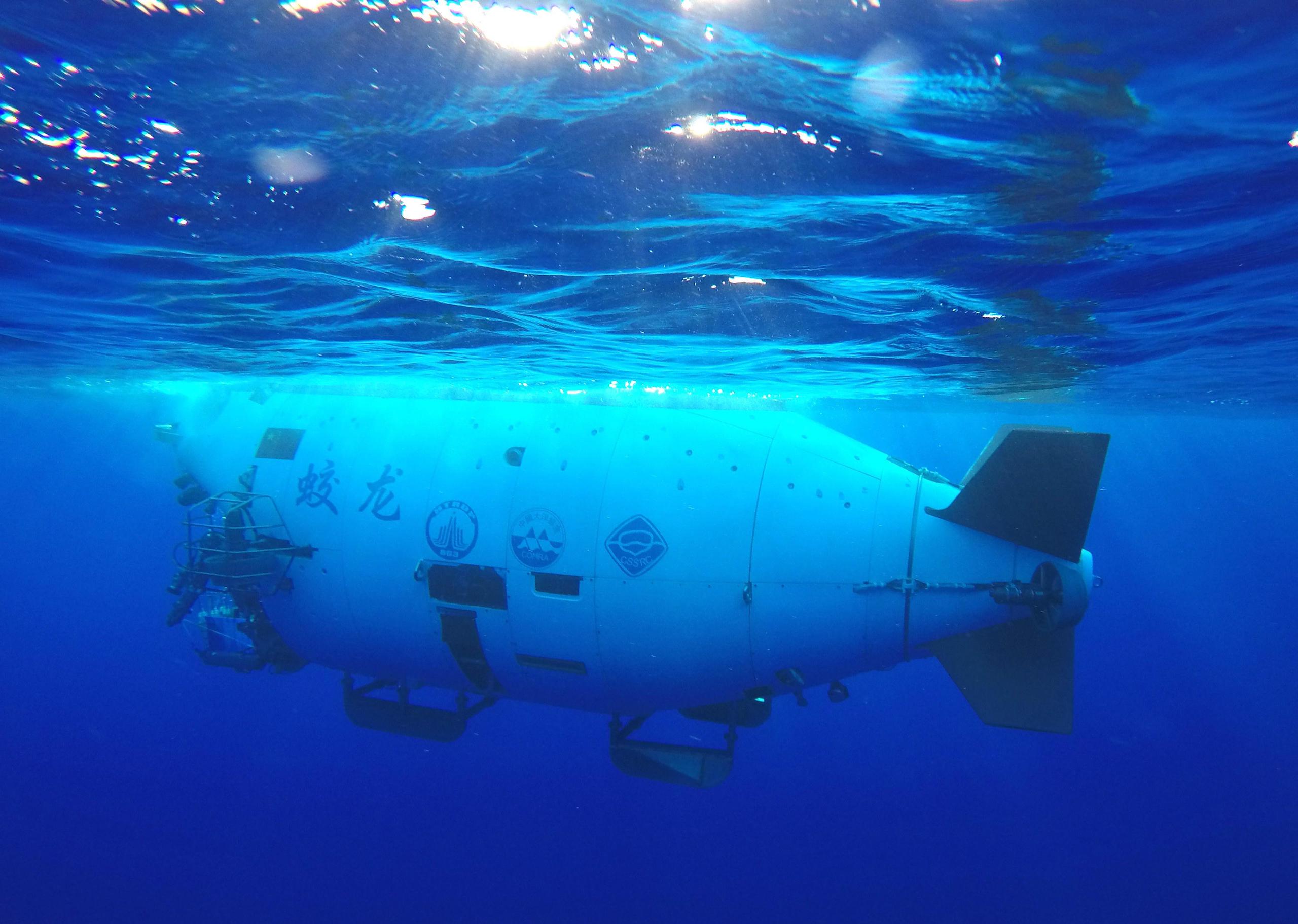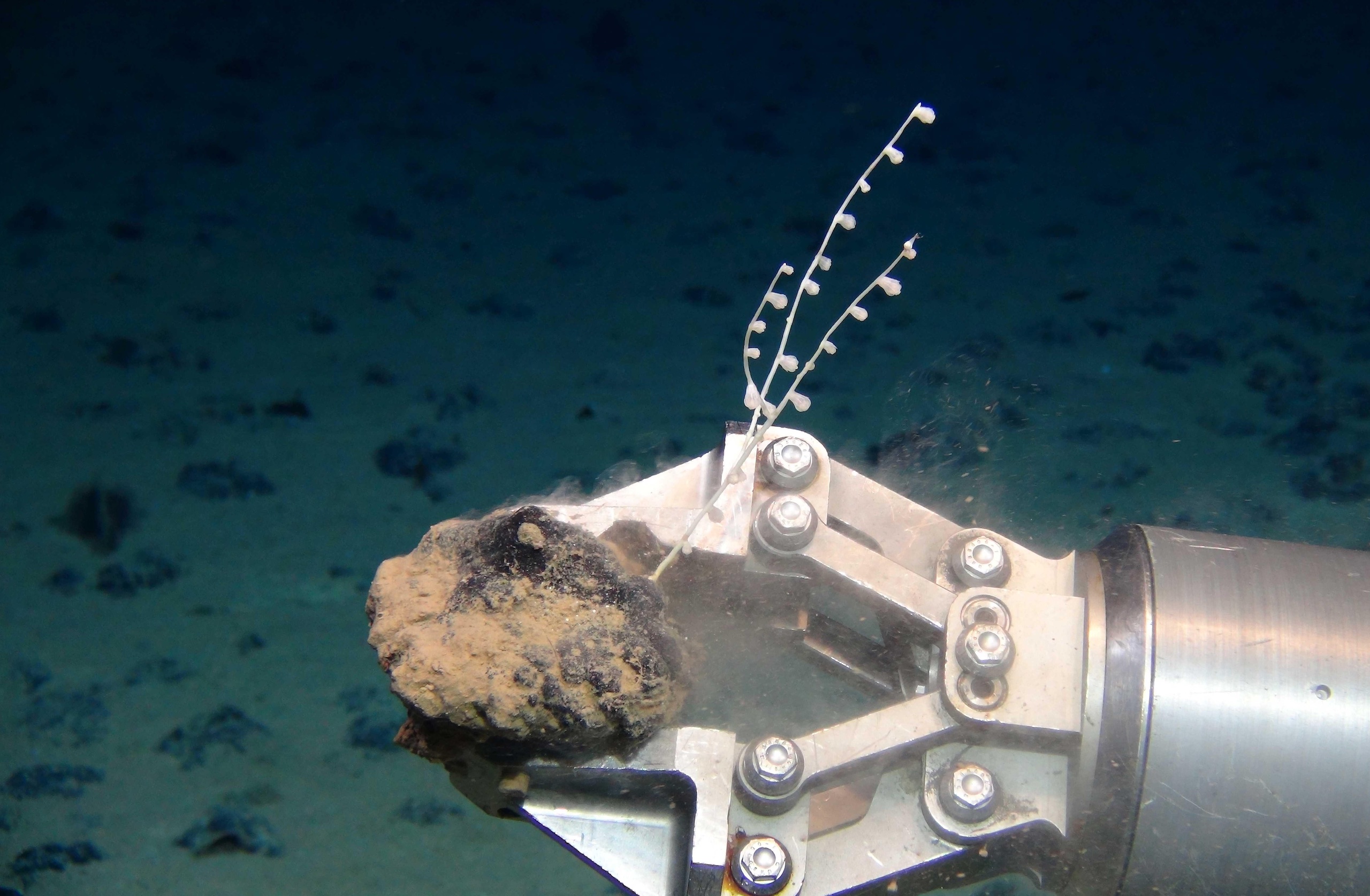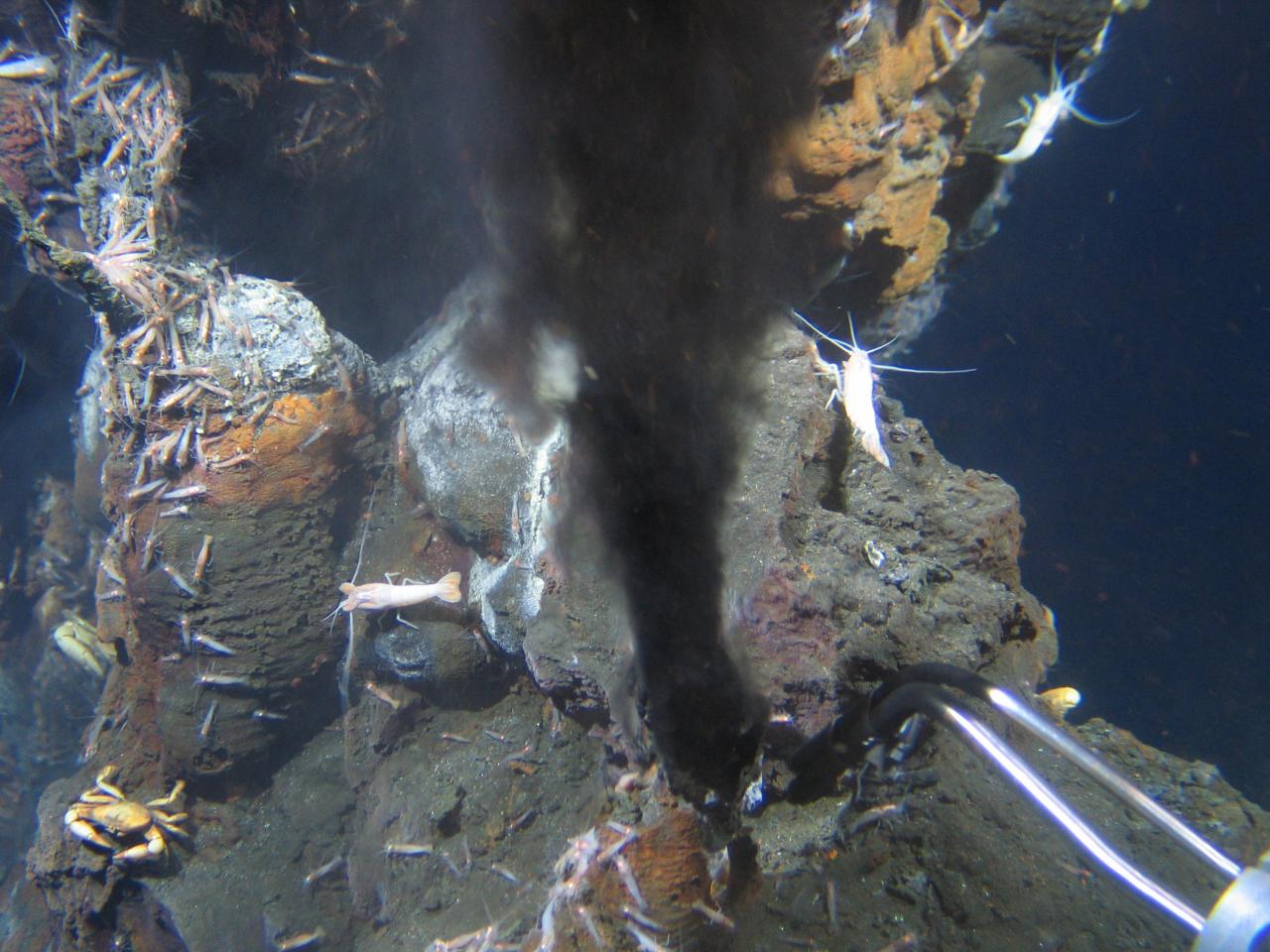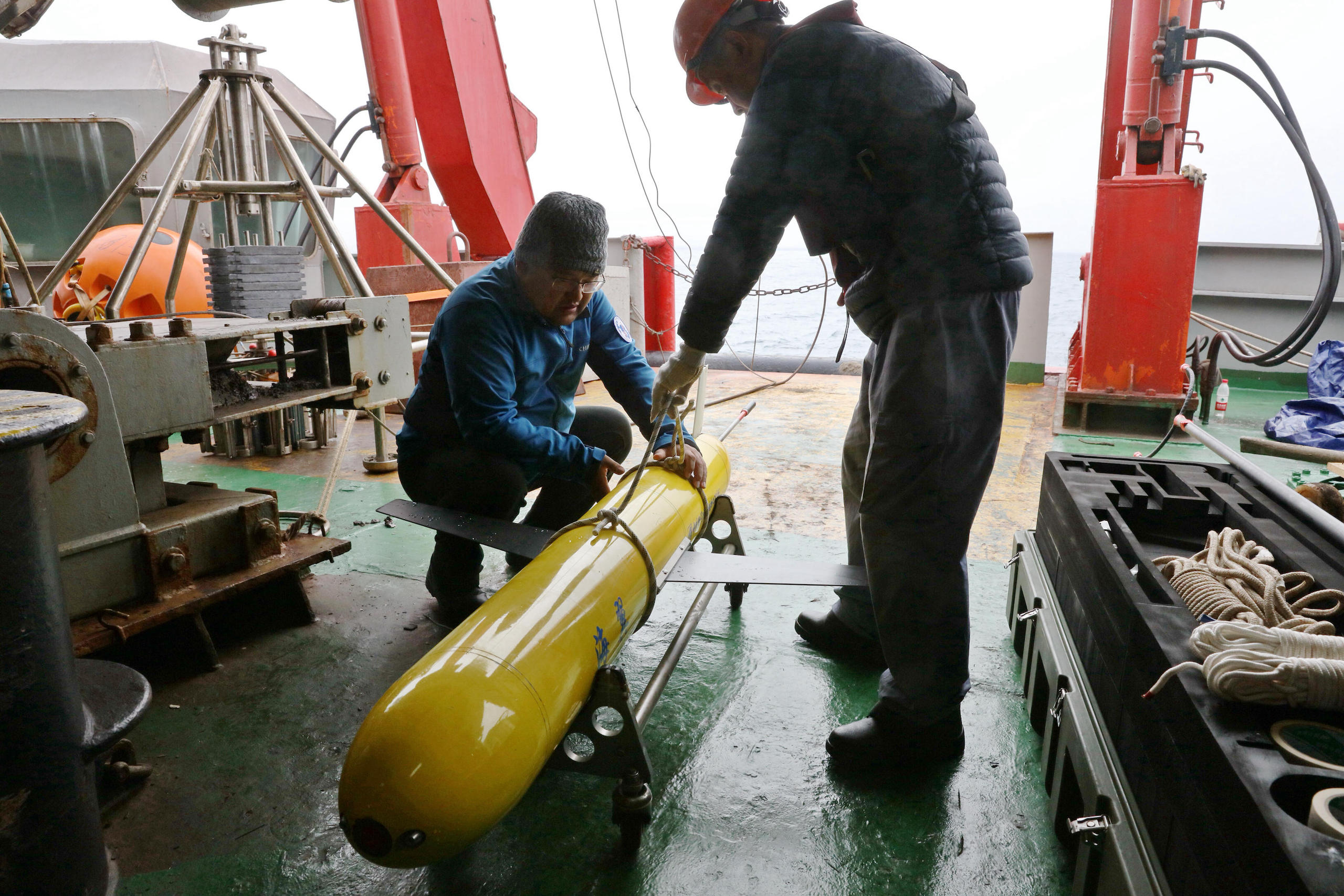
The Jiaolong manned submersible is dispatched on a dive to survey the Mariana Trench at a depth of 6,700 meters (Image: Alamy)
From China Dialogue Ocean by Zhang Chun, Liu Jun
Demand for resources in the seabed and a need to protect the deep-sea environment have spurred development of submersibles. Can they help us unlock the mysteries of the ocean?
The Ministry of Science and Technology named a self-powered “soft robot” submersible that survived the pressure of the Mariana Trench as one of China’s 10 biggest technological achievements in 2021.
This wasn’t the first time that the deepest part of the world’s oceans have been explored, but the robot, built by a team from Zhejiang University and research institute Zhejiang Lab, was the lightest submersible ever to make the trip.
Weighing less than 250 grams, it is shaped somewhat like a snailfish, with the same two flapping dorsal fins.
Its success has opened up new possibilities for exploring the deep sea.
The Ministry of Science and Technology named a self-powered “soft robot” submersible that survived the pressure of the Mariana Trench as one of China’s 10 biggest technological achievements in 2021.
This wasn’t the first time that the deepest part of the world’s oceans have been explored, but the robot, built by a team from Zhejiang University and research institute Zhejiang Lab, was the lightest submersible ever to make the trip.
Weighing less than 250 grams, it is shaped somewhat like a snailfish, with the same two flapping dorsal fins.
Its success has opened up new possibilities for exploring the deep sea.
The soft robot submersible developed by a team of Chinese scientists swims at 3,224 metres during a field test
This video shows the deep-sea free swimming of soft robot in the South China Sea.
This video shows the deep-sea free swimming of soft robot in the South China Sea.
The soft robot was grasped by a robotic arm on ‘HAIMA’ ROV and reached the bottom of the South China Sea (depth of 3,224 m).
After the releasing, the soft robot was actuated with an on-board AC voltage of 8 kV at 1 Hz and demonstrated free swimming locomotion with its flapping fins.
The front view and side view of swimming process were recorded by the cameras and LED lights on the ROV.
This video shows the potential of soft robots in deep-sea exploration.
(Video © Li Guorui et al)
The “deep sea” refers to any ocean waters more than 200 metres deep – the depth at which there’s no longer enough light for photosynthesis.
Four-fifths of the ocean is much deeper still, at over 2,000 meters.
There, the darkness is joined by crushing pressure and exploration becomes hugely challenging; only a few dozen people have ever travelled into the Mariana Trench.
The very deepest point of the trench, Challenger Deep, is the same distance from sea level as seven Eiffel towers stacked on top of Mount Everest.
The pressure at the bottom is equivalent to a tonne of weight pressing on a fingernail.
To avoid being crushed, submersibles generally need tough outer shells.
Manned submersibles have the highest requirements and can easily cost in the hundreds of millions of dollars and take years to build.
But that has not stopped deep-sea explorers.
Down in the depths, rich mineral resources and diverse ecosystems can be found.
The ocean absorbs one-third of humanity’s carbon dioxide emissions, which is of huge significance for climate change.
It is a source of both food and medicine.
And it may hold the secrets to the origins of life on Earth and its subsequent evolution.
Despite a later start than the US, Japan and France, China too has developed submersibles to prospect for seabed resources, search for ocean life, and help to understand and tackle climate change.
Its first manned submersible, launched in 1986, was intended for underwater rescues and had a maximum depth of only 300 metres.
In 1997, the unmanned submersible CR-01 successfully reached a depth of 5,179 metres.
Chinese manned submersibles capable of exploring deeper waters didn’t appear until 2009, with trials of a submersible named Jiaolong.
It would be another decade before Chinese explorers reached the bottom of the Mariana Trench.
Over these years, China has developed manned submersibles, unmanned underwater robots and underwater gliders, laying a foundation for future deep-sea exploration.
So, how will these different vehicles help us explore the deep ocean?
Towards seabed mining

Name: CR-01
Launched: 1995
Max operational depth: 6,000m
Operation: Autonomous
The CR-01 is a self-propelled robotic vehicle that can follow a programmed trajectory and carry out survey tasks such as taking photos and measuring temperature and salinity (Graphic: Manuel Bortoletti / China Dialogue Ocean.)
Launched: 1995
Max operational depth: 6,000m
Operation: Autonomous
The CR-01 is a self-propelled robotic vehicle that can follow a programmed trajectory and carry out survey tasks such as taking photos and measuring temperature and salinity (Graphic: Manuel Bortoletti / China Dialogue Ocean.)
The CR-01 is an autonomous underwater vehicle, or AUV, able to reach depths of 6,000 metres, and therefore 98% of the seabed.
Launched in 1995 and with a torpedo-like appearance, it can follow a programmed trajectory to gather measurements and take photographs.
But it is only a seabed observer – it cannot carry out more complex tasks such as collecting samples.
The CR-01 was one of the world’s earliest successes in prospecting for underwater minerals.
In 1991, the China Ocean Mineral Resources R&D Association (COMRA) was registered as the fifth pioneer investor in deep-sea mining with bodies working to establish the International Seabed Authority (ISA).
A few years later, the ISA approved COMRA’s plans to carry out initial surveys of 150,000 square kilometres of seabed in the northeast Pacific.
In the early summer of 1997, the CR-01 underwent 39 days of sea trials, supported by the vessel Da Yang 1.
It surveyed marine mineral deposits known as polymetallic nodules on the seabed at depths of up to 5,179 metres, as well as taking photographs and temperature and salinity readings.
The successful completion of its mission was key to China gaining the unique right to prospect for minerals across 75,000 square kilometres of seabed, as well as priority development rights, in 1999.

A deep-sea coral on a polymetallic nodule from the Clarion Clipperton Zone in the central Pacific, one of the areas in which pioneer deep-sea miners have shown greatest interest
The ISA was founded in 1994 to regulate seabed prospecting and exploitation, in accordance with the United Nations Convention on the Law of the Sea.
It issued 31 exploration contractsto various nations, which also gained priority in development rights to the contracted areas.
But there is not yet agreement on a “Mining Code”, and so actual mineral extraction has not started.
One of the sticking points is how to avoid mining causing devastation to the deep-sea environment.
After all, we have explored only 5% of the seabed and know little about deep-sea organisms and ecologies.
The Jiaolong submersible, a manned deep-sea submersible owned by COMRA with the capability to go to depths of more than 7,000 metres, is able to reach 99.8% of the seabed.
Its development was linked to COMRA’s increasing involvement in surveying the international seabed, and the state’s increasingly urgent need for manned submersibles.
Such submersibles can be more precise in selecting samples and carry out more comprehensive observations.
While they can prospect for minerals and take samples of seabed silt, minerals, water and organisms, their most important function is helping China and the world understand seabed organisms.
Exploring new life

Name: Jiaolong
Launched: 2009
Deepest dive: 7,062m
Operation: Manned
Capable of carrying three crew, the Jiaolong has robotic arms to collect samples of mineral deposits and deep-sea organisms.
It can also record video and use sonar to create detailed maps, among other capabilities.
(Graphic: Manuel Bortoletti / China Dialogue Ocean)
Launched: 2009
Deepest dive: 7,062m
Operation: Manned
Capable of carrying three crew, the Jiaolong has robotic arms to collect samples of mineral deposits and deep-sea organisms.
It can also record video and use sonar to create detailed maps, among other capabilities.
(Graphic: Manuel Bortoletti / China Dialogue Ocean)
On Christmas Eve 2014, the Jiaolong – having completed a number of diving trials to depths of 7,000 metres – was launched from the Xiang Yang Hong 9 survey vessel to carry out its 35th ocean survey.
This time, its destination was the mid-ocean ridge in the southwest Indian Ocean.
Marine biologist Xiao Xiang summed up the aim of the mission: “In scientific terms, we all want to see if the biodiversity here is more like that of the Pacific or the Atlantic.”
He added: “The southwest Indian Ocean is one of the least studied ocean areas.”
The Jiaolong discovered and took a sample from a black smoker – a type of hydrothermal vent – and also collected silt and water samples from a depth of 2,000 metres.
Xiao Xiang hopes to use the single-celled organisms found within the black smoker to help explain how life on Earth began.
The Jiaolong discovered and took a sample from a black smoker – a type of hydrothermal vent – and also collected silt and water samples from a depth of 2,000 metres.
Xiao Xiang hopes to use the single-celled organisms found within the black smoker to help explain how life on Earth began.

A black smoker on the Mid-Atlantic Ridge swarming with deep-sea shrimps (Image: ROV KIEL 6000 / GEOMAR, CC BY)

Deep-sea snails collected by the Jiaolong during its mission to study hydrothermal vents in the southwest Indian Ocean (Image: Zhang Xudong / Alamy)
The ocean depths teem with new species awaiting discovery.
In 2019 alone, 66 were identifiedby scientists from around the world including China.
With its maximum depth of 7,000 metres, the Jiaolong can carry out geophysical and biological studies on almost all of the seabed, but not all.
In November 2020, the “Fendouzhe” (or “Striver”), another three-person submersible, reached some of the deepest parts of the Mariana Trench, bringing back samples of rocks, seawater and organisms.
In October 2021, it started surveying the trench.
The “Mariana Trench biology and environment research program” was formally started during this ocean survey.
Its intention is to “invite researchers from China and overseas to participate in research into the Mariana Trench, to work together to study deep-sea geophysical change, how life developed and adapted to different environments, and biodiversity and climate change.”
Such grand plans will need help from cheaper and more flexible unmanned submersibles.
The lightest unmanned submersibles are usually designed only to make observations and take measurements.
The heaviest “work class” underwater robots have manipulator arms to allow for work such as construction and welding, while “light work class” submersibles sit between the two.

Scientists on the Chinese icebreaker Xue Long prepare to launch a Haiyi deep-sea glider in the Bering Sea (Image: Shen Cheng / Alamy)
Currently, China has five models of unmanned submersible, ranging from observation class to light work class, which have reached depths of 10,000 metres.
The Haidou 1 was developed by the Chinese Academy of Sciences’ Shenyang Institute of Automation in 2016.
It has three operating modes: tethered by a cable, for optimum signal transmission; untethered; and a hybrid mode where the submersible navigates independently but the cable remains connected.
As a light work class submersible, the Haidou 1 has manipulator arms that can operate at great depths and grab or place items, to some extent replicating the functionality of manned submersibles.
Gathering ocean data

Name: Haiyan-X
Launched: 2020
Deepest dive: 10,619m
Operation: Autonomous
The Haiyan-X is one of a series of gliders designed to follow ocean eddies and survey conditions such as salinity and acoustics over long periods of time.
Mimicking the function of fish bladders, it uses gas to control its buoyancy, rising to the surface to transmit data.
(Graphic: Manuel Bortoletti / China Dialogue Ocean)
Launched: 2020
Deepest dive: 10,619m
Operation: Autonomous
The Haiyan-X is one of a series of gliders designed to follow ocean eddies and survey conditions such as salinity and acoustics over long periods of time.
Mimicking the function of fish bladders, it uses gas to control its buoyancy, rising to the surface to transmit data.
(Graphic: Manuel Bortoletti / China Dialogue Ocean)
Many submersibles can measure temperature, salinity and oxygen levels at different depths.
That data helps us keep up to date on how the oceans are changing and take appropriate climate change mitigation and adaptation measures.
In 2013, a team led by Wu Lixin, a Chinese scientist, came up with the “Transparent Ocean” plan.
A key aim was to use modern ocean monitoring and exploration tech to gather real-time ocean data and create a high-resolution network of observations.
Alongside satellites and floats known as Argo floats, underwater gliders are also used to gather ocean data.
Resembling small planes, with two wings and a tailplane, they control their buoyancy vertically to descend into deeper water and then rise up again to the surface, where they can send the data they have gathered back to a receiving station.
The lateral movement of Tianjin University’s Haiyan gliders is directed by ocean eddies.
The Haiyan-X can reach depths of around 10,000 metres and in July 2020 spent six days carrying out deep-sea observations, gathering cross-sectional profile data including several at depths between 3,000 and 10,619 metres and sending back information on salinity and acoustics, as well as imagery.
In 2018, the Shenyang Institute of Automation’s Haiyi gliders were used by China’s 9thexpedition to the Arctic and launched in the Bering Sea.
This was the first use of China’s underwater gliders in its Arctic research.
In 2017, an ocean dataset compiled by Chinese scientists was used for the first time by the Intergovernmental Panel on Climate Change in its special report on the ocean.
Underwater trends

Name: TBC
First deep-sea trials: 2019
Deepest dive: 10,900m
Operation: Autonomous
Inspired by the Mariana hadal snailfish, this 22cm-long robot can withstand enormous pressure thanks to its soft silicon body and the decentralised positions of its electronics.
Its functionality as a research tool is still being developed.
(Graphic: Manuel Bortoletti / China Dialogue Ocean)
First deep-sea trials: 2019
Deepest dive: 10,900m
Operation: Autonomous
Inspired by the Mariana hadal snailfish, this 22cm-long robot can withstand enormous pressure thanks to its soft silicon body and the decentralised positions of its electronics.
Its functionality as a research tool is still being developed.
(Graphic: Manuel Bortoletti / China Dialogue Ocean)
Unlike submersibles with solid hulls, the soft robot being developed by scientists in Zhejiang mimics the structure of snailfish that live thousands of metres deep.
The necessary circuits and batteries are embedded in a soft silicon body designed to withstand huge pressures.
The robot is 22cm long and 28cm wide and can move in straight lines or curves by moving its “fins”, just like a snailfish.
Smaller, lighter and cheaper than other deep-sea equipment, the invention means new possibilities for deep-sea exploration, and particularly the study of seabed microenvironments.
Globally, dozens of manned and hundreds of unmanned submersibles are in use.
Both types have their advantages, and both are needed.
Manned submersibles are complex and precise machines, requiring specialist personnel to operate.
The Chinese ocean science community is currently training more of these pilots.
Unmanned submersibles are cheaper and more flexible.
China has developed a range of underwater robots according to its varying needs in its own and international waters.
Alongside the roles described above, they can also be used for oil and gas prospecting, environmental studies, rescues, underwater archaeology and the inspection and repair of underwater pipelines and cables.
The soft robot developed by scientists in Zhejiang was inspired by a snailfish discovered in 2014 in the Mariana Trench.
This footage of the species was filmed at a depth of 7,485 metres.
(Video © SOI / HADES / University of Aberdeen (Dr Alan Jamieson))
This footage of the species was filmed at a depth of 7,485 metres.
(Video © SOI / HADES / University of Aberdeen (Dr Alan Jamieson))
Costs are an unavoidable issue for all scientists carrying out ocean research.
Lower-cost, unmanned submersibles will be able to carry out an increasing range of research tasks as they become smarter, more operable, and better able to communicate with the surface.
The soft robot which travelled to Challenger Deep does not currently gather information.
But the development team plans to design new materials and structures, and make it smarter, more capable and more efficient.
In the future, it may be able to take precise samples from coral reefs or caves, becoming a valuable tool for marine biologists.
Links :
- GeoGarage blog : China’s new extra-large submarine drones revealed / Chinese manned deep-sea submersible gets rare look at deepest ocean depths, the Mariana Trench / China becomes fifth country to acquire deep-diving technology / China is planning a massive sea lab 10000 feet underwater / A maritime revolution is coming, and no one’s in the wheelhouse

No comments:
Post a Comment